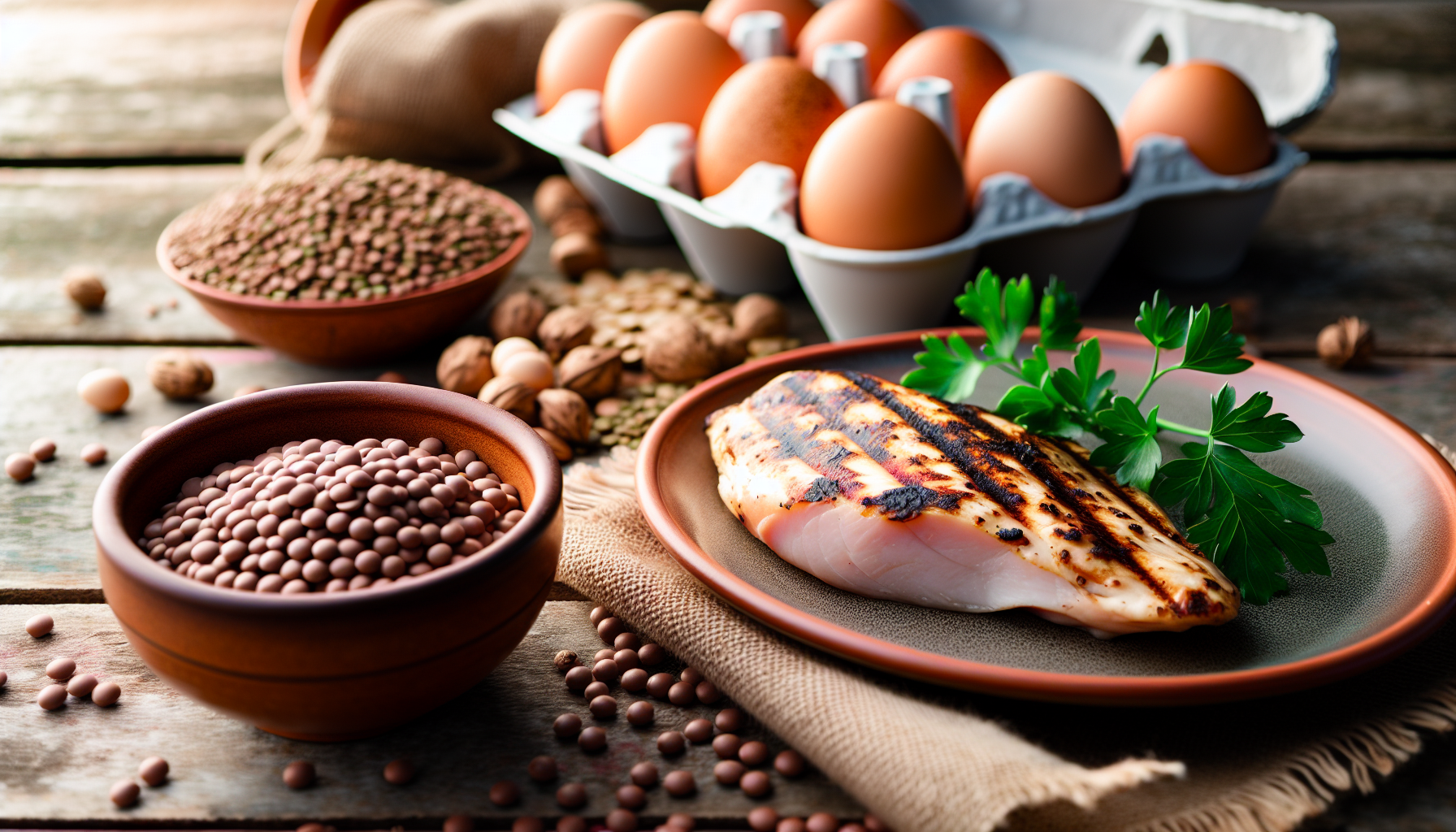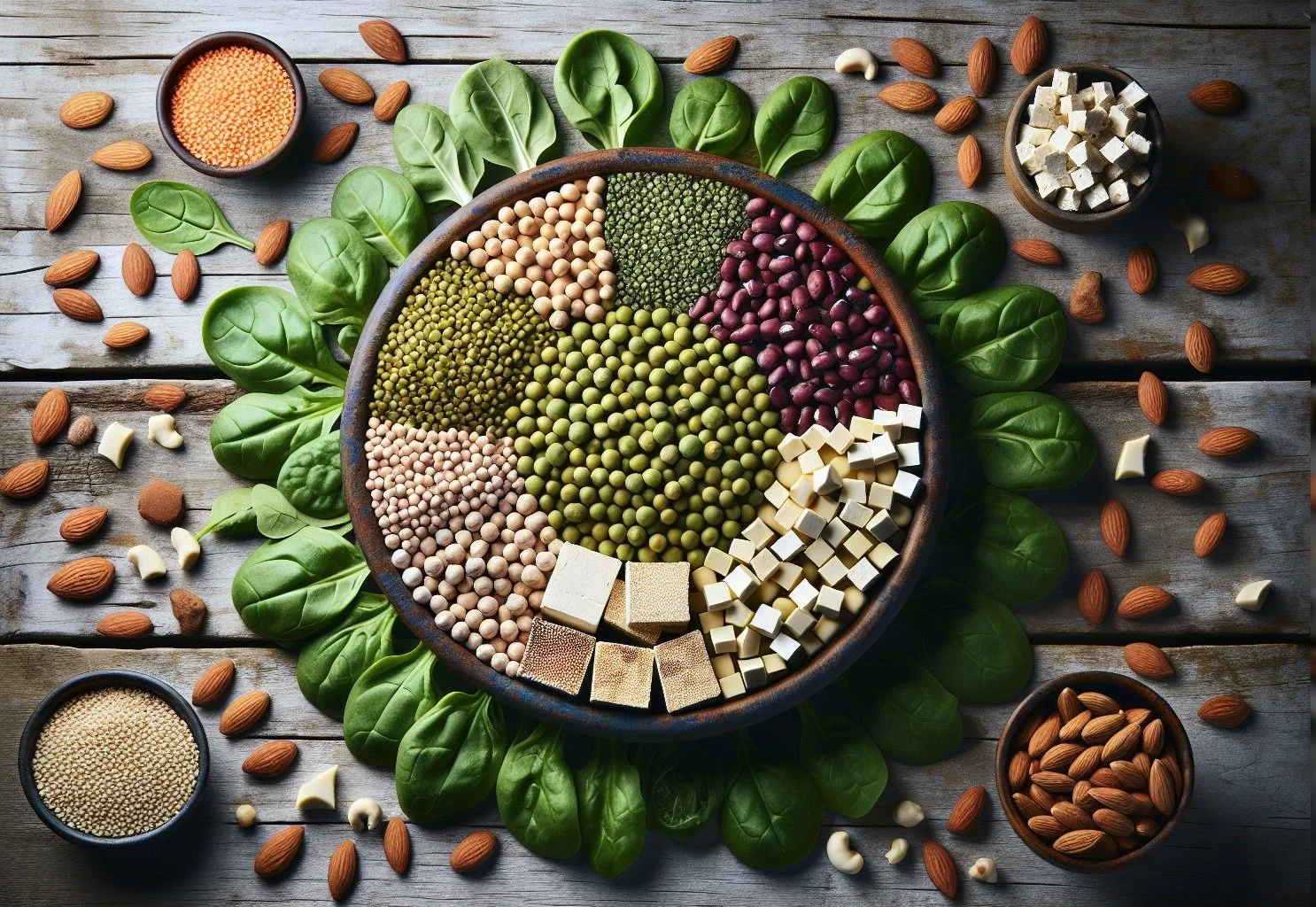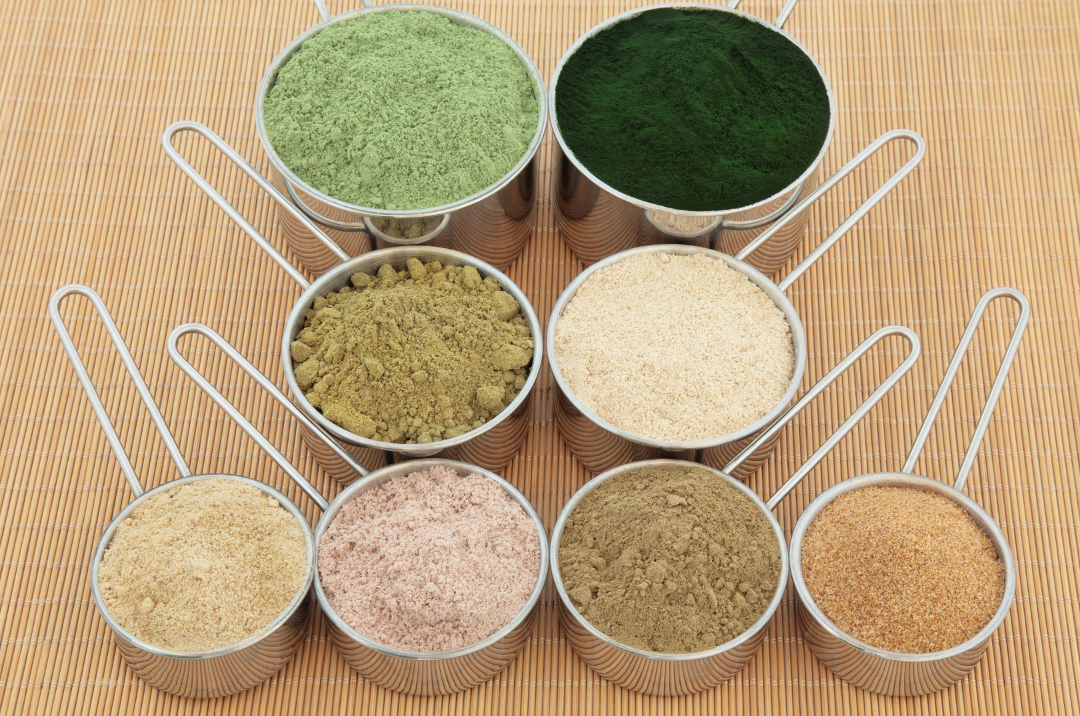Discover Which Food Is High in Protein for Optimal Nutrition
Which food is high in protein? From building muscle to boosting metabolism, protein is a nutritional cornerstone. But not all protein sources are created equal. This article cuts straight to the chase, listing the top animal and plant-based proteins and offering insights into balancing these most important nutrients in your diet without the fluff or sales talk.
Key Takeaways
Protein is a crucial macronutrient for muscle growth, immune function, and cell health, with essential amino acids playing key roles in bodily functions, and both animal and plant-based foods can be rich sources of protein.
Combining different incomplete protein sources like beans and grains throughout the day, as well as including complete protein sources like soy products and animal protein, can help achieve a balanced and sufficient intake of essential amino acids.
While protein powders and supplements can augment a diet, especially when whole food sources of protein are unavailable, excessive protein intake can have negative health effects and should be moderated with a balanced and varied diet.
The Power of Protein: Why It's Essential
A symphony of protein: golden grilled chicken breast, delicious brown eggs, a scattering of earthy lentils, and a handful of tree nuts artfully arranged. Each element, a melody of health, together composing a harmonious plate that sings the virtues of strength and vitality.
Protein serves as a foundational macronutrient that is critical for the advancement of muscle growth, immune capabilities, and general wellness. It plays an essential role in not only muscles, but also bones, skin, hair—in fact nearly all cellular structures within our bodies utilize this vital nutrient. But what makes protein so important? Its significance can be found in its capacity to support the repair and expansion of muscles. It heals damaged cells post-exercise, helps preserve and maintain muscle mass during caloric deficits, and when paired with weight training exercises, enhances both muscular size and strength.
Proteins are more than just the building blocks of muscle; they are the maestros of our immune symphony, orchestrating gene expression, crafting antibodies, and conducting the production of cytokines. Skimping on protein can leave the immune system out of tune, increasing susceptibility to infections. It's important to note that recommended dietary allowances (RDAs) represent ideal protein consumption levels. For optimal health, and as discussed in a comprehensive review in Nature Reviews Endocrinology, intake above these minimums is often recommended. Notably, both insufficient protein intake and excessive consumption can lead to health complications, including metabolic resistance, prediabetes, and type 2 diabetes mellitus (T2DM).
Essential Amino Acids
The proteins that are so vital to our bodies’ functionality have their roots in amino acids, which serve as their fundamental components. Within these amino acids lies the key. Nine of them, known as essential amino acids, must be sourced from our diet because they play critical roles in a myriad of physiological processes. For example, Valine is indispensable for muscle growth, tissue repair and renewal. It also plays a significant role in generating energy for the body’s needs. Similarly crucial is Histidine, which contributes to immune system efficiency while also playing a part in digestion processes and affecting sleep patterns along with sexual health through its role in histamine production.
Continuing down this list brings forth several other pivotal amino acids alongside their primary functions.
Isoleucine aids metabolism within muscles, bolsters immune responses, stimulates hemoglobin creation and regulates energy.
Leucine enhances protein synthesis while assisting growth hormone secretion, repairs muscular tissues, accelerates wound healing process and helps manage blood glucose levels.
Lysine steps into various areas such as facilitating hormone secretion, supplying energy reserves, ensuring effective calcium assimilation for bone health as well boosting immunity aspects.
Methionine drives forward tissue proliferation aids overall metabolic rate assists detoxifying mechanisms whilst supporting mineral absorption inclusive of zinc plus selenium.
Phenylalanine stands out by contributing to neurotransmitter manufacturing including dopamine and norepinephrine — all foundational brain chemicals along with promoting additional amino acid formation itself.
Threonine fortifies skin integrity complemented by connective tissue support Pushing blood clot efficacy fat breakdown coupled with underpinning defensive bodily systems against pathogens or external harm stimuli.
Tryptophan holds significance preserving an ideal nitrogen balance inside the body acting additionally as serotonin precursor thus overseeing mood fluctuations appetite control together with sleep cycle management.
Complete vs. Incomplete Proteins
Recognizing the critical importance of essential amino acids, we can distinguish between complete and incomplete proteins. Complete proteins are those that provide every essential amino acid necessary for our bodies. These are predominantly found in animal-derived foods such as meat and eggs, but also exist in certain plant-based options like soy products. Notably, quinoa stands out among plants because it boasts a full spectrum of all nine essential amino acids.
On the other hand, incomplete proteins are missing one or more of these crucial components. Yet this doesn’t mean your entire intake needs to come from a single meal. You can achieve your daily requirement by consuming various incomplete protein sources throughout the day. With this knowledge about protein types, we’re better equipped to make dietary decisions that ensure an adequate consumption of all required essential amino acids for optimal health.
Top High-Protein Foods for a Balanced Diet
Amidst the rustic backdrop of a wooden table, an array of animal-based proteins: succulent pink salmon, golden-yolked eggs, and tender chicken, each telling a tale of nature's bounty, promising strength and vitality for those who partake in their rich, muscle-building essence.
Understanding the importance of protein might lead you to wonder about potential sources for incorporating high-protein foods into your diet. Fortunately, there is a wide array of food options rich in protein. Some key high-protein sources include:
lean meats
poultry
fish and other seafoods
eggs
beans
nuts
seeds
soy-based products
Take Greek yogurt as an example. It’s an excellent choice to include in your meals with its impressive content of nearly 20 grams of protein for every 7 ounces served.
When focusing on enhancing your protein intake, the caliber of the chosen proteins should not be overlooked. Opting for healthier, higher quality proteins like salmon, yogurt or beans instead of red meat can provide not just ample amounts but also a variety of essential nutrients that contribute toward maintaining a well-rounded diet.
Animal-Based Protein Sources
Sources of protein derived from animals, including lean meats, dairy products, and eggs, are typically abundant in grams of protein and boast complete sets of essential amino acids. These qualities render them an integral component to a balanced diet. A selection of animal-based proteins with their respective content includes:
Shrimp (for every 3 ounces): contains 19 grams of protein
Chicken breast (per 3 ounces): provides a substantial 26 grams of protein
Greek yogurt (a serving size is usually around six ounces): has about 17 grams of protein
Cottage cheese (half a cup serving size): offers up to 14 grams of protein
One large egg delivers slightly more than six grams of protein
Each option brings its unique offering within the array.
Milk, various cheeses, and yogurts stand out as high-protein dairy items that effectively contribute this vital nutrient into your regular diet. Canned fish or select cuts from quality meats such as beef, pork, poultry or lamb, serve as strong sources of protein. It’s pivotal to watch portion sizes and preferentially pick lean protein options. This approach will elevate meal-time muscle-building macros without adding unnecessary calories.
Plant-Based Protein Sources
Amidst a verdant spread, the plant kingdom's protein warriors stand proud. Legumes, nuts, and seeds, a mosaic of nourishment. Each a tiny titan, together they form a tapestry of sustenance, whispering the ancient secret of vitality—nature's very own muscle-building symphony.
For those who embrace a vegetarian or vegan lifestyle, or simply opt for plant-based nutrition, there’s an abundance of high-protein choices available. Take lentils as an example: they pack a substantial amount of plant-based protein, delivering 18 grams per cooked cup. Similarly, garbanzo beans are another great option providing you with 14.5 grams of protein in each cup.
You also have other robust sources of plant-based proteins such as:
Tempeh: this fermented soy product offers 20 grams of protein in just a 3-ounce serving
Edamame: these young legumes not only contain more protein than many other options but come loaded with healthful flavonoids
Soy products like tofu and textured vegetable protein are foundational foods in the vegan diet due to their comparable animal-like levels of dietary proteins.
Remarkably with more than enough protein already, several plant-derived foods qualify either fully or nearly as complete proteins. Among these are soybeans, amaranth grains, quinoa seeds, hemp seed hearts, chia seeds, buckwheat groats and spirulina algae.
Maximizing Protein Intake: Tips and Tricks
Understanding the significance of protein in our diet, it’s beneficial to evaluate methods for enhancing our daily protein consumption. This can involve making deliberate choices to integrate foods high in protein into each meal and snack we have. Consider replacing a bowl of morning cereal with eggs to amplify your breakfast’s protein content or beginning meals by focusing on the protein element first, which may help you feel fuller and more nutritionally satisfied.
As an illustration, pairing fruits with natural peanut butter that doesn’t contain added sugar is both tasty and an effective strategy for increasing your overall intake of proteins. Selecting lean jerky from pasture-raised animals provides a convenient option for ampping up your intake while on the move. Similarly versatile is cottage cheese. This dairy staple rich in proteins complements many dishes effectively when seeking that extra dose of high quality protein and nutrients.
If pondering how much protein one should consume daily comes across as puzzling, it doesn’t need to be overwhelming. By thoughtfully choosing items throughout the day loaded with these essential building blocks, achieving a target range between 100-150 grams becomes attainable without undue stress.
Protein-Packed Meal Ideas
On a plate of culinary balance, grilled chicken breast, the star, is flanked by an ensemble of vibrant grilled veggies and quinoa—a medley of flavors. Each bite is a step towards vitality, a symphony of protein-rich nourishment, fueling the body with every delicious, healthful forkful.
Incorporating more protein into your diet can be a fun and easy process. Start the day off strong with a breakfast that combines peanut butter on whole wheat bread, ensuring you get all nine essential amino acids for a complete source of protein. Alternatively, prepare an energizing breakfast burrito filled with black beans, eggs, cheese along with nutrient-rich vegetables such as sweet potatoes and avocados to boost your morning intake of protein.
When it comes to lunch or dinner options, consider incorporating edamame beans either as a standalone snack or mixed into dishes like stir-fries, salads, soups, or alongside rice — offering an impressive 18 grams of protein per one-cup serving. Creating a hearty smoothie using components such as walnuts and nut butters plus chia seeds or flaxseeds will enhance the meal’s protein content. Choose from cow’s milk, soy milk or pea milk to mix in for yet another surge in overall dietary protein.
High-Protein Snacks
Looking for quick, high-protein snacks to curb those hunger pangs between meals? Here are some options:
Celery sticks with peanut butter: approximately 9 grams of protein per 2-tablespoon serving
Hard-boiled eggs: around 6 grams of protein per egg
Canned sardines: about 8 grams of protein per sardine
These snacks offer easy portability and a good amount of protein to keep you satisfied.
Packaged nut butter portions are easy to carry and contain around 9 grams of protein, providing a quick, high-protein snacking option. Or for a protein-packed snack, layer Greek yogurt with granola and mixed berries to create a nutritious parfait. The options are endless. The key is to opt for snacks that are not only high in protein but also offer other vital nutrients to keep you energized throughout the day.
Meeting Protein Needs on a Vegetarian or Vegan Diet
If the thought crosses your mind, “What about those following a vegetarian or vegan diet?” rest assured that fulfilling your protein needs without consuming meat is entirely achievable. Vegetarians and vegans can not only meet but frequently surpass the basic thresholds necessary for adequate protein consumption.
It’s essential to be conscientious about where you get your proteins from. A plant-based regimen can adequately provide all of one’s protein requirements when it includes entirely plant-derived proteins like soy, pea, or hemp products. By doing so, individuals on a vegan diet can confidently reach their daily recommended intake of this vital nutrient.
Combining Plant Proteins
Vegetarians and vegans can achieve a well-rounded consumption of essential amino acids by strategically pairing plant protein sources. Since various plant foods contain different profiles of these vital building blocks, incorporating a mix into the diet is key.
Creating combinations such as grains with legumes or nuts and seeds paired with legumes provides the complete array of essential amino acids needed for a comprehensive protein source. It’s not necessary to ingest every essential amino acid in one sitting. Spreading out intake of assorted plant-based proteins over multiple meals throughout the day effectively fulfills the body’s requirements for all indispensable amino acids.
Soy Products: A Complete Plant Protein
Soy stands out among plant-based proteins and is highly favored by vegetarians and vegans for its rich protein content. Foods derived from soy, such as tofu, tempeh, and edamame, are packed with high-quality plant-based protein. They earn the title of complete protein because they supply all nine essential amino acids required by our bodies, thus making them a pivotal component in maintaining a well-rounded diet.
For individuals who do not consume dairy products or animal-derived proteins, they can turn to soy protein as an excellent alternative source of complete protein. It caters perfectly to vegan diets, allowing one to adhere to a high-protein nutritional regimen without having to forsake their dietary principles or restrictions.
The Role of Protein Powders and Supplements
While whole foods should continue to be the main source of nutrients, there are particular scenarios where protein powders and supplements can be beneficial. For example, when making protein shakes with an assortment of protein powders, each scoop provides 20-25 grams of protein. This offers a practical advantage by facilitating increased and more convenient intake of protein while on the move—a challenge often posed by whole food options.
Protein powders and supplements can play a significant role in supporting muscle recovery after exercising as well as helping manage weight during diets that are extremely low in calories. They can adapt to fit individual nutritional requirements.
Choosing the Right Protein Powder
In a kaleidoscope of wellness, protein powders stand in vibrant unity. Whey, soy, pea—each a promise of strength. A scoop, a blend, a shake; the ritual for muscle's embrace. Here, fitness enthusiasts find their powdered muse, fueling journeys of health with each measured pour.
Navigating the vast selection of protein powders on the market can be overwhelming. The quality of a protein powder is significantly influenced by its biological value, which indicates how effectively your body can absorb and use the protein to foster muscle growth. Whey protein stands out as an excellent option due to its comprehensive amino acid composition and swift assimilation into the body.
For those who are lactose intolerant or aiming to reduce cholesterol intake, soy protein powder might be an appropriate alternative. Diabetic individuals should opt for shakes that do not contain added sugars while people with kidney issues should seek out options with a reduced amount of protein content. It’s important to consult a healthcare professional before selecting a suitable protein powder that caters precisely to your unique dietary requirements and health objectives.
When to Use Protein Supplements
When should you use protein supplements? Well, the ideal timing for protein supplementation varies among studies. Some suggest its effectiveness with meals for weight management, others cite benefits post-exercise to boost protein synthesis.
However, it’s important to remember that supplements should not replace whole foods. They should be used as an additional tool to help you reach your protein goals when you’re unable to do so through food alone. For instance, protein powders can be used to create high-protein shakes or smoothies for a convenient way to increase protein intake.
Or you can enhance your overnight oatmeal with protein-rich add-ins like Greek yogurt, nut butter, or protein powder, serving as a high-protein snack option.
Potential Risks of Excessive Protein Intake
It’s important to get enough protein in our diet, but we must also be mindful of the risks associated with consuming too much. High levels of protein intake can contribute to weight gain and elevated cholesterol because some high-protein foods contain significant amounts of saturated fat. Diets that are rich in proteins like red meat have been linked with an increased risk for heart disease as well as certain cancers such as those affecting the colon and breast.
The body may experience adverse effects from consuming excessive amounts of protein, including:
A disruption in bone and calcium balance which might lead to more frequent bone loss and fractures
Negative impacts on kidney function which could elevate the likelihood of developing kidney stones or worsen pre-existing mild renal issues
Potential liver function disorders particularly when extreme quantities are ingested through supplements.
To maintain health without overdoing it, moderate consumption of sufficient protein is key. Seeking advice from a healthcare expert will ensure your dietary choices align with personalized nutritional needs.
Balancing Protein with Other Nutrients
Maintaining overall health necessitates a healthy diet, that is diverse and well-portioned. The significance of protein notwithstanding, other macronutrients such as carbohydrates and fats are also essential. A balanced diet should incorporate an assortment of edibles including:
green vegetables
assorted fruits
ample fiber
sufficient amounts of protein
Embracing a nutritious eating plan is critical to fostering good health and sustaining an appropriate body weight.
Take nuts like almonds for instance. They offer not only healthy fats but also substantial protein content, along with vital nutrients like:
dietary fiber
vitamin E
manganese
magnesium
Those suffering from medical conditions such as kidney disease might encounter adverse effects from high-protein diets and ought to seek medical advice for achieving nutritional balance in their diets.
Summary
In summary, the intake of protein is a critical component for maintaining overall health and facilitating muscle growth. Protein not only supports immune function, but also participates in numerous bodily functions. Proteins derived from animals contain all necessary amino acids, yet plant-based proteins can equally fulfill our protein requirements when suitably mixed. Supplements containing protein might prove advantageous, particularly for individuals with particular dietary restrictions. Nevertheless, it is imperative to harmonize your consumption of proteins with other vital nutrients while remaining cognizant of the hazards associated with an overabundance of protein intake.
Frequently Asked Questions
Which food is king of protein?
Excellent sources of protein include lean cuts of chicken and pork, various fish types, tofu, beans, lentils, low-fat dairy products such as cheese and milk, seeds like chia or flaxseed, nuts ranging from almonds to walnuts, as well as eggs.
How can I eat a lot of protein?
Incorporating Greek yogurt, collagen supplements, and selecting carbohydrates that are high in protein can significantly boost your protein intake. Consuming healthy protein sources from lean meats, poultry, seafood, eggs along with plant-based options like beans, nuts, seeds and soy products will also contribute to a diet rich in protein.
What foods are the highest in protein?
Lean meats such as beef and chicken, seafood such as salmon, along with eggs and lentils rank among the foods richest in protein.
Including these items in your diet is beneficial for enhancing your intake of protein, which can lead to improved overall health and aid in repairing muscles.
What are the essential amino acids?
Valine, Histidine, Isoleucine, Leucine, Lysine, Methionine, Phenylalanine, Threonine, and Tryptophan are all essential amino acids. These compounds are pivotal for a range of bodily functions.
Can vegetarians and vegans meet their protein needs?
Certainly, individuals following vegetarian or vegan diets can effortlessly fulfill their protein requirements by incorporating a variety of plant-based protein sources such as beans, lentils, quinoa, and tofu into their meals to ensure they obtain all essential amino acids.
References
Cheng H, Kong J, Underwood C, Petocz P, Hirani V, Dawson B, O'Leary F. Systematic review and meta-analysis of the effect of protein and amino acid supplements in older adults with acute or chronic conditions. Br J Nutr. 2018 Mar;119(5):527-542. doi: 10.1017/S0007114517003816. PMID: 29508691.
Holeček M. Histidine in Health and Disease: Metabolism, Physiological Importance, and Use as a Supplement. Nutrients. 2020 Mar 22;12(3):848. doi: 10.3390/nu12030848. PMID: 32235743; PMCID: PMC7146355.
Lopez MJ, Mohiuddin SS. Biochemistry, Essential Amino Acids. 2024 Apr 30. In: StatPearls [Internet]. Treasure Island (FL): StatPearls Publishing; 2024 Jan–. PMID: 32496725.
Mittendorfer B, Klein S, Fontana L. A word of caution against excessive protein intake. Nat Rev Endocrinol. 2020 Jan;16(1):59-66. doi: 10.1038/s41574-019-0274-7. Epub 2019 Nov 14. PMID: 31728051.
Additional Resources
Additional Reading
Understanding Food Nutrition Labels
Unlock the Power of Flavonoids: The Ultimate Guide to Their Health Benefits
Is a Plant-Based Diet Right for You? Weighing the Benefits and Risks
Maximizing Muscle Recovery Tactics for Athlete Performance
5 Sustainable Weight Loss Strategies That Really Work
Unsweetened Milked Almond: Health Benefits and Recipes for 2024
Where to Purchase Products
Disclaimer
The information provided in this article is for educational and informational purposes only and is not intended as medical advice. While we strive to provide accurate and up-to-date information, we make no representations or warranties of any kind, express or implied, about the completeness, accuracy, reliability, suitability, or availability with respect to the content. The information contained herein should not be used as a substitute for the advice of an appropriately qualified and licensed physician or other healthcare provider. The suggestions and insights should not be used for diagnosing or treating a health problem or disease, or prescribing any medication. Always seek the advice of your physician or other qualified health provider with any questions you may have regarding a medical condition or treatment and before undertaking a new health care regimen. Never disregard professional medical advice or delay in seeking it because of something you have read on this site.





